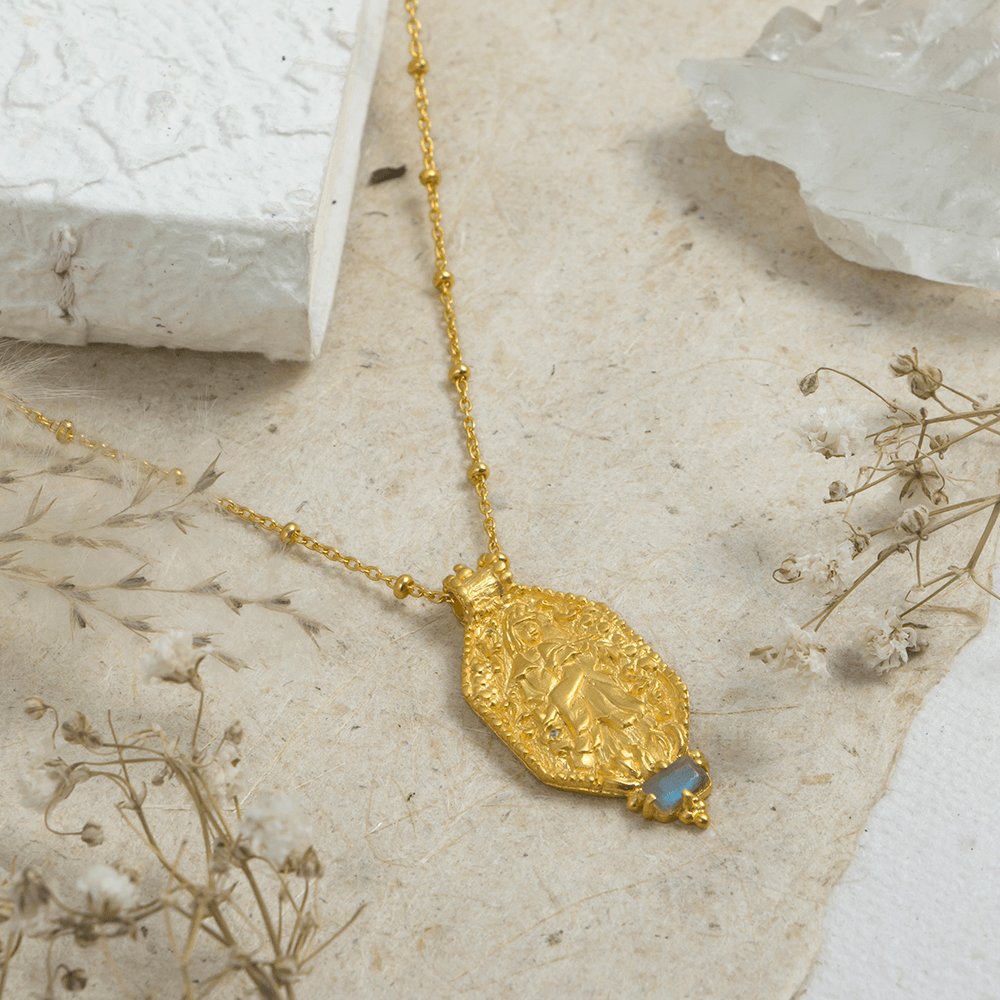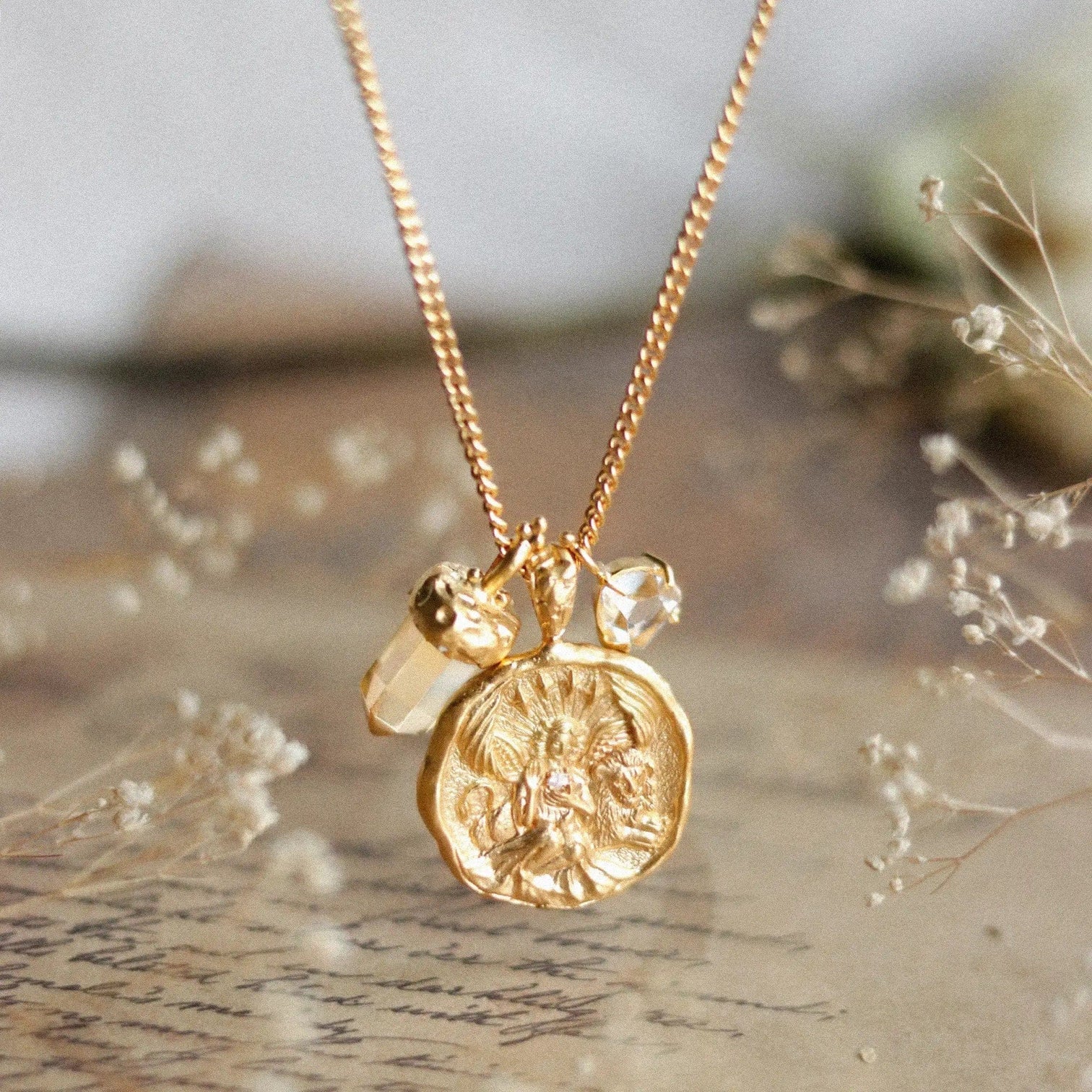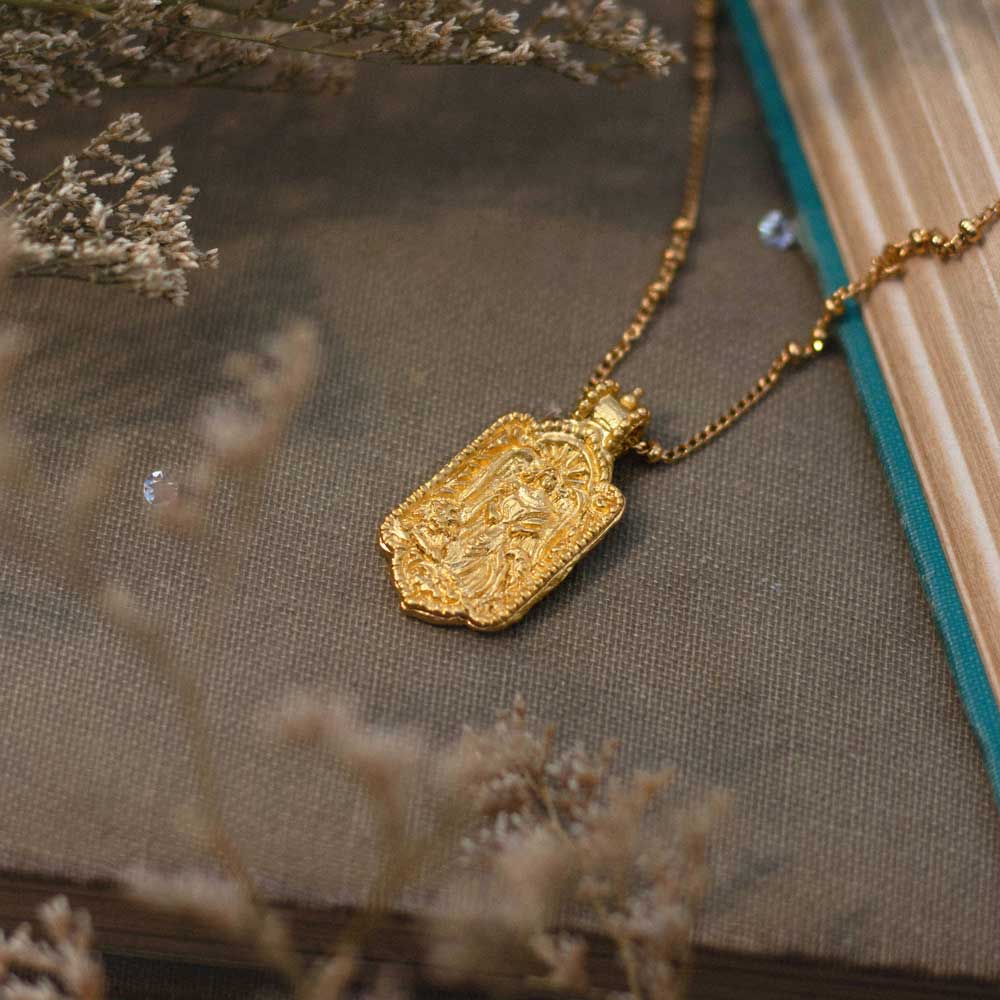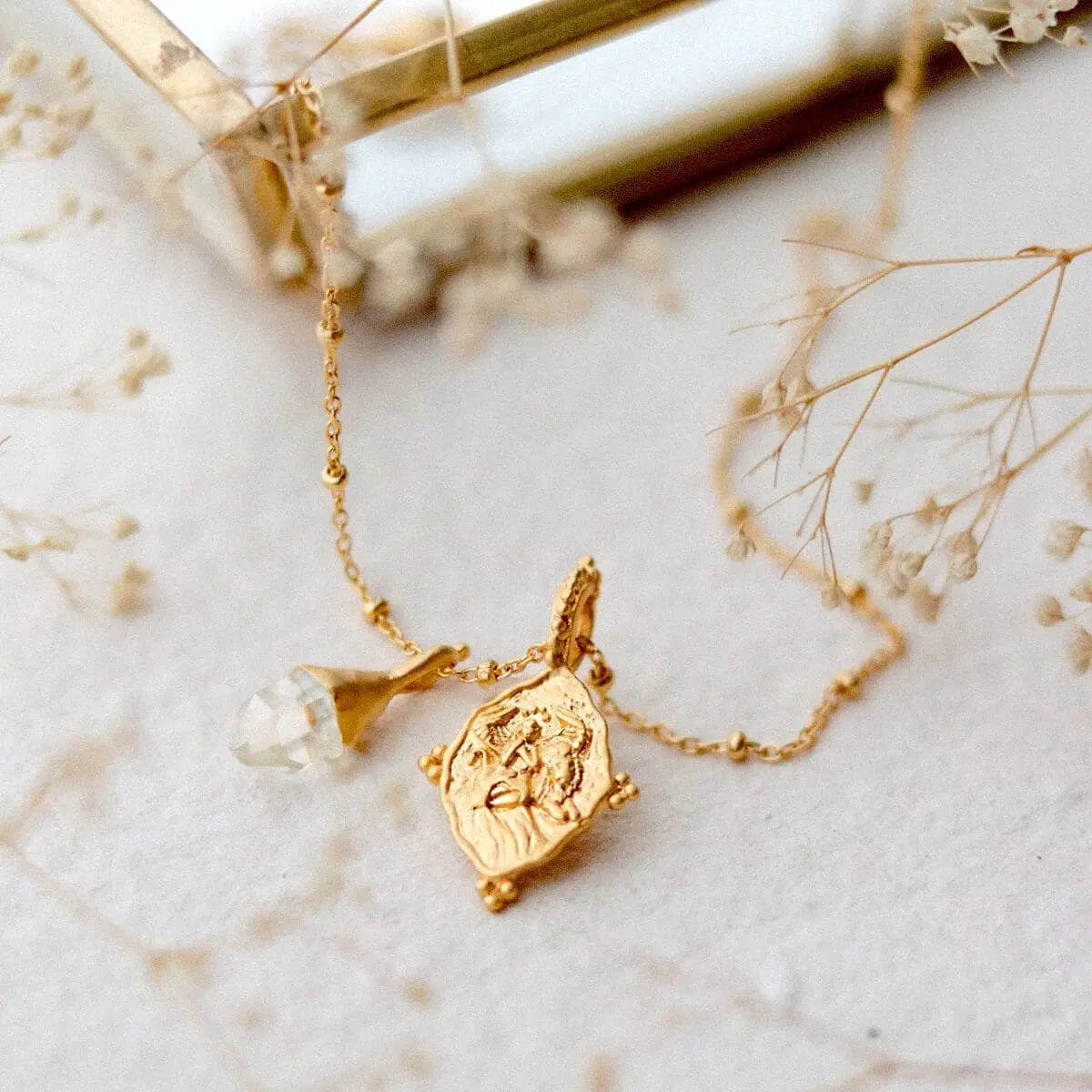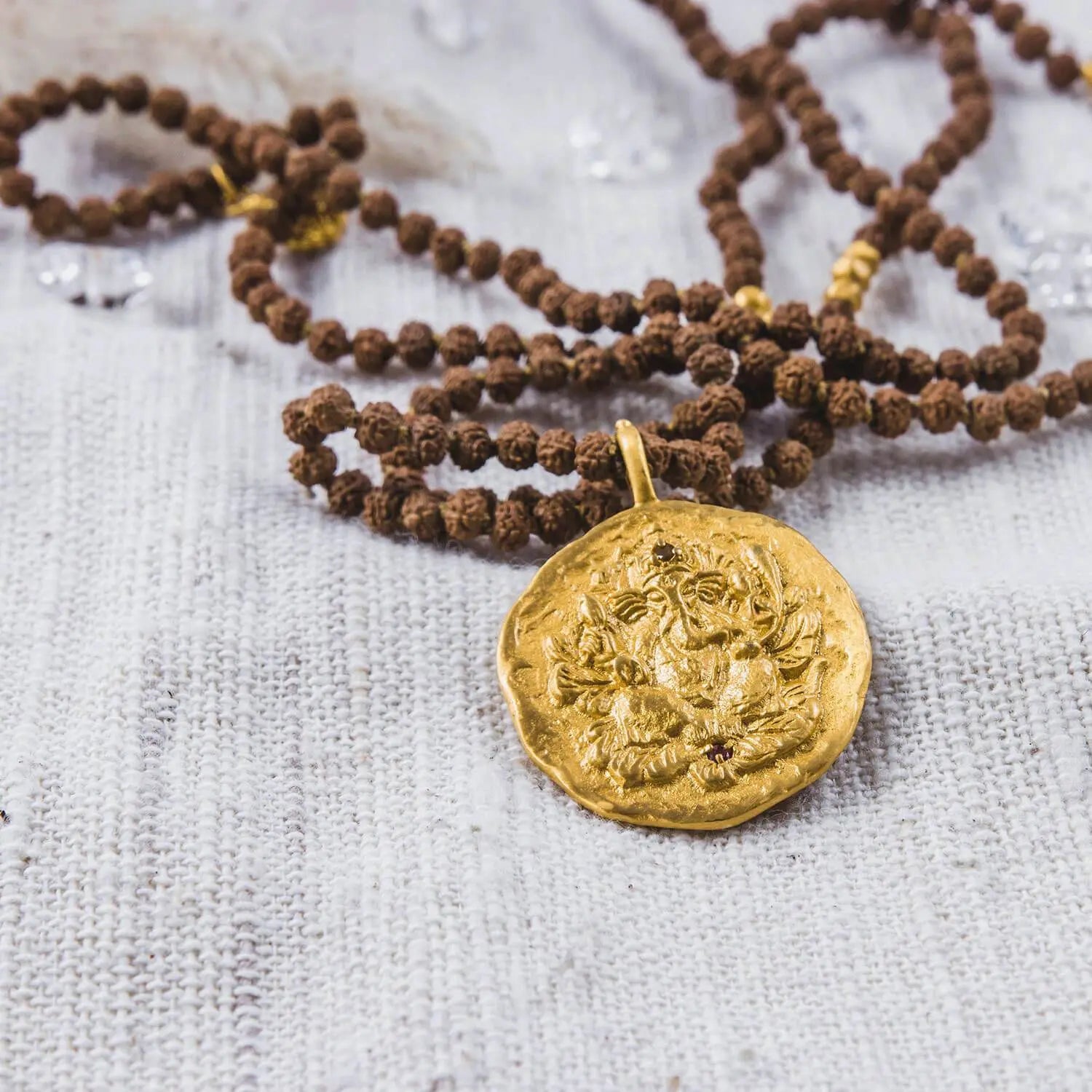
Throughout the history of our world, animals have always played a crucial and important part in the evolution of nature and humankind. Animals have been revered, feared, admired, used, and they often carry profound symbolism in various cultures around the world. For centuries, in fairytales, myths, sagas, legends and tales animals have reflected different aspects of human culture, spirituality, and mythology and have experienced an evolution each on their own.
Our collections often reflect or work with the energy of a god, angel or saint – however, there are also pieces that carry a specific meaning or intention based on a creature of nature.
In the following we are exploring the energies of different animals we have been working with in past collections.
The Dragon

Images: Left - Kuan Yin. Source - Pinterest. Right - My Love is Powerful Necklace
The dragon in our Kuan Yin piece ‘My love is powerful’ is a mythical creature that combines the features of various animals and has captivated human imagination for millennia. Its symbolism is as complex as its many depictions. Their history, meaning, and symbolism vary significantly from one culture to another.
In Western cultures, the dragon is often seen as a symbol of chaos, destruction, and malevolence. In many European cultures for example, dragons are often portrayed as malevolent creatures that hoard treasure and terrorize villages. They symbolize chaos, danger, and the struggle of good versus evil. In some cases, dragons can also represent the guardian of hidden knowledge or a test of heroism.
However, in Eastern cultures, especially in Chinese folklore, dragons are revered as powerful and benevolent beings symbolizing strength, wisdom, and good luck. They are often associated with water, bringing rain and prosperity. The Chinese dragon is associated with the emperor and is a symbol of imperial power.
The dragon as Kuan Yin's companion enhances her spiritual significance and emphasizes her role as a compassionate and powerful figure in Buddhism.
The dragon is often associated with transformation and change. In the context of Kuan Yin, this can be seen as a representation of her ability to facilitate spiritual transformation and lead beings from ignorance to enlightenment. The dragon is a symbol of her guidance in the process of personal and spiritual growth.
Kuan Yin's association with the dragon also emphasizes her compassionate strength. Dragons are traditionally seen as powerful and majestic creatures. When Kuan Yin is depicted riding a dragon, it conveys her ability to harness this power for the benefit of all sentient beings. She uses her strength not for personal gain but to bring about positive change in the world.
When Kuan Yin is linked with the dragon, it signifies her role in bringing harmony to the lives of those who seek her help. She is believed to restore balance and alleviate suffering, much like the calming influence of the dragon. Dragons are often seen as creatures that unite opposites, such as the elements of water and air. This symbolism aligns with Kuan Yin's embodiment of compassion and wisdom. She unites the qualities of compassion and wisdom, guiding individuals to find a harmonious balance between these seemingly contrasting attributes.
The dragon represents transformation, protection, strength, and the ability to bring about positive change, all of which align with Kuan Yin's attributes as a bodhisattva of compassion and mercy.
The Lion

The lion, often known as the "King of all animals,” holds a universal meaning of strength, courage, and majesty. In various cultures, the lion represents nobility, leadership, and protection. In Christianity, the lion is often associated with Jesus Christ, symbolizing his bravery and resurrection. In Hinduism, the lion is the vehicle of the goddess Durga, representing her ferocity and power. Lions are also prominent in African cultures, where they are revered as symbols of bravery, royalty, and the cycle of life.
Lions in Christianity symbolize various qualities, including the power of God, Christ's resurrection (the Lion of Judah), and protection. They are often depicted as guardians of sacred places or representing Christ's authority over evil.
The Lion can be found in our ‘Hold me with care’, 'Honor This Body' and ‘Gentle devotion’ pieces. Archangel Ariel’s name translates as Lion of God which is why we combined her symbol with the one of the lion. She is known as the guardian of nature, animals, and divine magic. This non-binary being invites us to reconnect with our instinctive essence deeply intertwined with Mother Nature.
The lion stands as a symbol of strength, guidance and character and in deep connection with the earth and as a protector of her.
The Deer

Deer are often admired for their graceful and gentle nature and hold a significant place in the cultural and symbolic landscapes of various cultures around the world.
Deer have been a vital part of Native American cultures for thousands of years, providing sustenance, clothing, and tools. In many Native American tribes, the deer is seen as a symbol of sensitivity, intuition, and gentleness. They believe that the deer has a special connection to the spirit world and can serve as a guide in matters of the heart and emotions.
Interestingly, in Hinduism, the deer is often associated with the deity Saraswati, the goddess of knowledge, art, and music. The gentle nature of the deer symbolizes the pursuit of knowledge and the importance of cultivating a calm and tranquil mind.
In Chinese culture, deer are associated with longevity and immortality.
In Celtic mythology, deer were often seen as otherworldly animals that traversed the boundaries between our world and the mystical realms.
In Celtic and European cultures, deer symbolize grace, purity, and spirituality. They are associated with the Goddess Artemis (or Diana in Roman mythology), who was a protector of animals and the wilderness, which is the goddess energy we designed our ’Force of nature’ and ‘Wild Spirit’ pieces for.
The deer holds significant symbolism in relation to the goddess Artemis. It represents the untamed aspects of nature, purity, duality, protection, freedom, and the moon. The deer, as a wild and graceful creature, symbolizes the untamed and natural aspects of the world. Its presence in Artemis's mythology underscores her connection to the wild and her role as a protector of the natural world. Deer are also often seen as symbols of purity and innocence due to their graceful appearance and gentle behavior. This quality aligns with Artemis's identity as a virgin goddess, emphasizing her purity and the chastity of her followers.
Artemis is further a skilled huntress and is often portrayed with a bow and arrows, accompanied by a pack of hunting dogs. The deer, as both prey and companion, symbolizes the duality of Artemis's role. She is both the fierce hunter who pursues deer and the guardian of these animals in her sacred groves. In this sense, the deer serves as a reminder of the delicate balance between hunting and conservation.
Deer are known for their swift and agile movements, often symbolizing freedom and independence. This quality resonates with Artemis's own independence and her rejection of traditional roles imposed on women in ancient Greek society. She embodies the idea of being unbound by societal constraints.
The Elephant

Elephants are majestic and highly symbolic creatures that symbolise strength, wisdom, and unity. Their close-knit family structures are seen as a symbol of community and social bonds.
In Buddhism, Elephants are associated with Buddha's birth. According to Buddhist tradition, Queen Maya dreamt of a white elephant before giving birth to Siddhartha Gautama, who later became Buddha. As such, elephants symbolize spiritual enlightenment, peace, and wisdom.
In Hinduism, the elephant-headed deity Ganesha is one of the most widely worshipped gods. Ganesha represents intellect, wisdom, and the removal of obstacles. Elephants also symbolize power, strength, and longevity in Indian culture. Ganesha is also the key figure of our Ganapati Mala. We have written a blogpost dedicated to Ganesha and the symbolism of the Elephant God - to learn more read here.
The Swan

Photo: Goddess Saraswati - by Mangku I Gusti Made Baret - Ubud's ARMA (Agung Rai Museum of Art).
Swans carry an elegant and graceful appearance and often encompasse themes of beauty, purity, transformation, and love.
In Greek mythology, swans were often linked to Apollo, the god of music and the arts. They were also believed to be the shape-shifted forms of various gods and heroes. Swans came to symbolize beauty, inspiration, and transformation.
In China, swans symbolize grace, beauty, and fidelity. They are often associated with love and marriage, and swan imagery is used in weddings to symbolize the eternal bond between couples.
Swans in Hinduism are associated with purity and spiritual significance. They represent the soul's journey towards self-realization and liberation (moksha). The swan is believed to have the ability to separate milk from water, symbolizing the ability to discern the eternal truth from the transient world, the evil from the good, the right from the wrong.
In Hinduism the goddess Saraswati is often depicted standing or sitting on a swan as her vehicle.
Saraswati is associated with discernment, wisdom, and the ability to differentiate between right and wrong, truth and falsehood. The symbolism of the swan reflects Saraswati's role in helping individuals discern between knowledge and ignorance.

Swans undergo a transformational process from cygnets to adults. This metamorphosis aligns with Saraswati's role in leading individuals from ignorance to enlightenment, from darkness to light. She aids in the transformative journey of spiritual growth and knowledge acquisition.
In Hindu spirituality, Saraswati is seen as the embodiment of higher consciousness and the pursuit of knowledge beyond worldly distractions. The swan, with its ability to glide gracefully on water, signifies the idea of navigating the waters of life with wisdom and spiritual insight.
Animals have a remarkable ability to capture the human imagination and convey a wide range of meanings and symbolism. Their symbolism is a testament to the rich tapestry of human culture, spirituality, and mythology. So, the next time you encounter one of these animals in art, literature, or nature, take a moment to reflect on the profound meanings they carry and the diverse ways they have shaped our understanding of the world.
Continue Exploring Symbolism in Jewelry:
Read About - The Art of Craftmanship: Behind The Scenes of Creating Animal Inspired Jewelry
Read About - Guardians of Tradition and Culture - Embracing The Wisdom of Elders
Read About - Galungan & Kuningan - A Balinese Celebration of Good Over Evil

